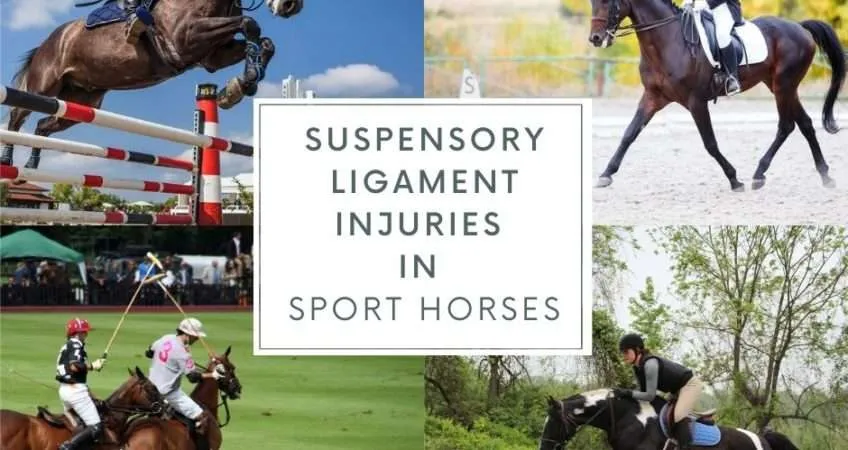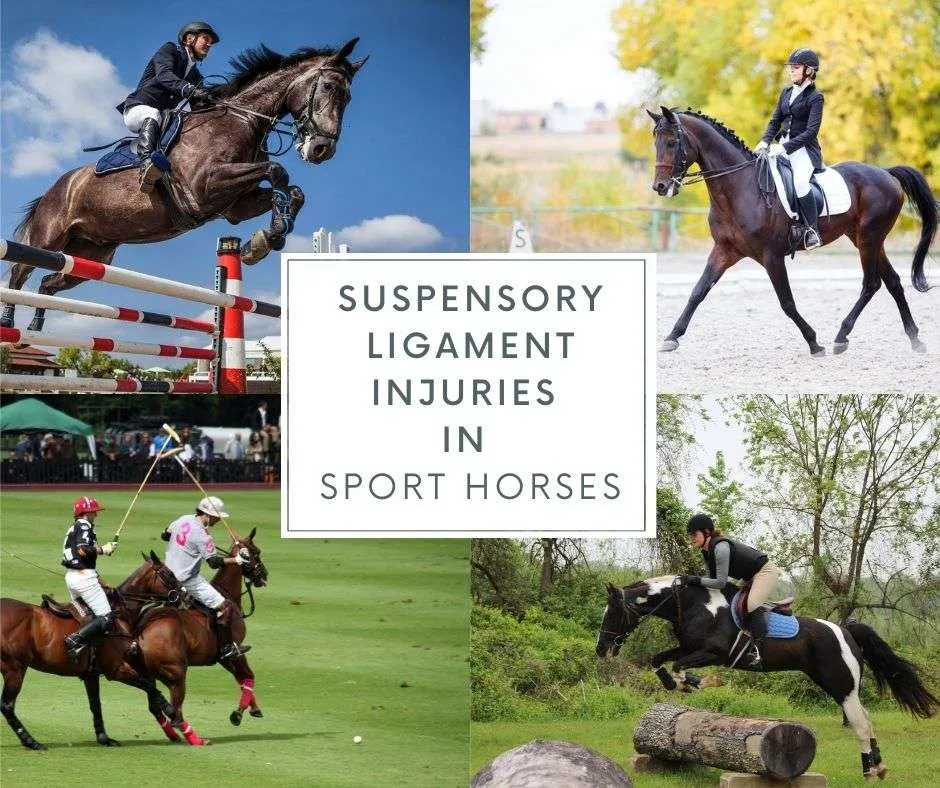Suspensory Feeding and Locomotionno Tail

Suspensory Ligament Injuries in Sport Horses

FEI-certified veterinarian, Duncan Peters, DVM, MS, heads the Sport Horse Program at Hagyard Equine Medical Center in Lexington, Kentucky. In this post he explains how suspensory ligament injuries in horses happen, how they're treated and how they may affect your horse's career.
"Jumping, speed, uneven ground and fatigue put eventers and jumpers at greater risk for injuries that are sudden and severe. Your horse lands awkwardly from a jump or sets his foot down badly on rough ground, and the result is a torn tendon or ligament.
Dressage horses may be less prone to "bad-step" injuries, but repetitive stress is a big factor for them. They're prone to muscle soreness, microscopic tears in ligaments and joint problems/injuries that can become chronic and limit what the horse can do.
Bringing your horse back from any injury can be frustrating. The damage may be hard to diagnose, and there are no cookbook formulas for recovery because no two injuries are exactly the same. Ideally, you'll keep your horse off the injured list.
SUSPENSORY LIGAMENT INJURIES
The suspensory ligament runs down the back of the cannon bone from just below the knee (or hock), splitting into two branches that pass around the back of the ankle and end on the front of the long pastern bone below. Its job is to support the ankle joint as it sinks underweight and returns to normal when the weight comes off.
If your horse overloads the leg, the suspensory may give way. The injury may be mild – a few of the ligament's tough collagen fibers tear – but repeated stress will make it worse. In a severe injury, the ligament may rupture or even fracture bone as it tears away.
Most at risk
Acute front suspensory tears are a particular danger for eventers and jumpers because speed and jumping increase the load on the forelimbs and the chances of a misstep. Hind suspensory injuries may be more common in dressage horses because these horses work more off their hind ends. Many are also heavy, which puts added strain on the ligament. Risk for all horses increases with work level and intensity, poor footing and lack of fitness.
Signs
Suspensory injuries can be tricky to spot. Lameness ranges from severe to barely noticeable, depending on how bad the damage is. If the tear is in the main body or the branches, the leg may be warm, swollen and sensitive at the site. But the top of the ligament is hidden by other structures, so you may not see those signs if the tear is high.
Local nerve blocks and a hands-on exam will help your veterinarian find the problem. An ultrasound scan may help pinpoint the exact location and reveal the extent of damage to the ligament, and X-rays will show if bone is involved.
Action
Your veterinarian will help you work out a treatment plan that suits your horse's specific injury. Treatment usually includes these steps:
- Cool down. Your vet may prescribe cold therapy (icing or cold-hosing several times a day) and a nonsteroidal anti-inflammatory drug to reduce inflammation.
- Stall rest to give the ligament time to heal. Your vet may advise standing wraps for the injured leg and the opposing leg.
- Hand-walking, to encourage healing. Follow your vet's advice, starting with as little as 10 minutes a day and gradually increasing the time.
- Gradual return to exercise. With your vet, set up a program that eases your horse back into work over several months, using ultrasound exams to monitor the ligament and adjust the program as needed.
- Depending on the case, your vet may suggest other therapies like shockwave treatment; new regenerative therapies, such as stem cells and platelet-rich plasma; or surgery.
How long will all this take?
Ligaments heal slowly. A mild strain may take six to eight weeks, but a tear can take eight to 12 months. High hind suspensory injuries can be especially frustrating because your horse's anatomy makes it hard to follow healing there and harder to know when your horse is ready to return to work. Keep in mind that he may trot sound long before the ligament is healed, and rushing his rehab is likely to cause a setback.
Outlook
Ligaments tend to heal poorly, with fibrous scar tissue that's prone to reinjury. While many horses make full recoveries, chronic suspensory problems require careful management. This can be a limiting factor for your horse, and it's hard to judge where the limit is. Even a sensitive rider won't pick up on the moment when her horse feels the first twinge of pain." [1]
[1] https://practicalhorsemanmag.com/health-archive/5-common-sport-horse-injuries-11606
reyesarinalwas1948.blogspot.com
Source: https://eliteequineuk.com/horses/suspensory-ligament-injuries-in-sport-horses/
0 Response to "Suspensory Feeding and Locomotionno Tail"
Post a Comment